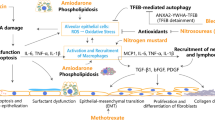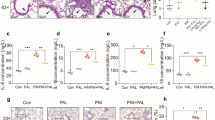Abstract
Tobacco induces oxidative stress in the alveolar epithelium and causes its damage. Retinoic acid (RA) has a cardinal role in alveolar cell growth, differentiation, and maturation. The aim of the study was to investigate the role of cell–cell interactions and whether RA could reverse the effect of tobacco extract on epithelial function as expressed by surfactant synthesis. For this, an in vitro model, which provides multiple cell type interactions, as seen in vivo, was used. We had used the major lung cell types, alveolar epithelial and mesenchymal cells represented by the cell lines A549 (human lung adenocarcinoma cell line), and human fetal lung fibroblast-1 (HFL-1) for developing the monoculture and co-culture systems and studied the effect of tobacco extract and retinoic acid. The effect of tobacco and retinoic acid both singly and in combination on proliferation and surfactant synthesis was analyzed. Retinoic acid induced proliferation and upregulated surfactant synthesis in monocultures and co-cultures. Tobacco extract at 100 μg/ml concentration decreased A549 proliferation and upregulated surfactant protein mRNA expression. In co-cultures treated with tobacco extract (100 μg/ml), retinoic acid (1 μM), regulated cell proliferation, and surfactant protein mRNA expression vis-à-vis the monoculture system. This clearly points to the fact that cell–cell interactions modulate the effect of additives or stimulants and help in assessing the in vivo combinatorial responses in vitro and that the retinoic acid effect is regenerative.







Similar content being viewed by others
References
Besnard V.; Nabeyrat E.; Henrion-Caude A.; Chadelat K.; Perin L.; Le Bouc Y.; Clement A. Protective role of retinoic acid from antiproliferative action of TNF-alpha on lung epithelial cells. Am. J. Physiol. Lung Cell. Mol. Physiol. 282: L863–L871; 2002.
Carnevali S.; Nakamura Y.; Mio T.; Liu X.; Takigawa K.; Romberger D. J.; Spurzem J. R.; Rennard S. I. Cigarette smoke extract inhibits fibroblast-mediated collagen gel contraction. Am. J. Physiol. 274: L591–L598; 1998.
Chytil F.; Riaz-ul H. Vitamin A mediated gene expression. Crit. Rev. Eukaryot. Gene Expr. 1: 61–73; 1990.
Fraslon C.; Bourbon J. R. Comparison of effects of epidermal and insulin-like growth factors, gastrin releasing peptide and retinoic acid on fetal lung cell growth and maturation in vitro. Biochim. Biophys. Acta 1123: 65–75; 1992.
Fraslon C.; Bourbon J. R. Retinoids control surfactant phospholipid biosynthesis in fetal rat lung. Am. J. Physiol. 266: L705–L712; 1994.
Griffin M.; Bhandari R.; Hamilton G.; Chan Y. C.; Powell J. T. Alveolar type II cell-fibroblast interactions, synthesis and secretion of surfactant and type I collagen. J. Cell Sci. 105: 423–432; 1993.
Grubor B.; Meyerholz D. K.; Lazic T.; DeMacedo M. M.; Derscheid R. J.; Hostetter J. M.; Gallup J. M.; DeMartini J. C.; Ackermann M. R. Regulation of surfactant protein and defensin mRNA expression in cultured ovine type II pneumocytes by all-trans retinoic acid and VEGF. Int. J. Exp. Pathol. 87: 393–403; 2006.
Heffner J. E.; Repine J. E. Pulmonary strategies of antioxidant defense. Am. Rev. Respir. Dis. 140: 531–554; 1989.
Hoogsteden H. C.; van Hal P. T.; Wijkhuijs J. M.; Hop W.; Verkaik A. P.; Hilvering C. Expression of the CD11/CD18 cell surface adhesion glycoprotein family on alveolar macrophages in smokers and nonsmokers. Chest 100: 1567–1571; 1991.
Ishii T.; Matsuse T.; Igarashi H.; Masuda M.; Teramoto S.; Ouchi Y. Tobacco smoke reduces viability in human lung fibroblasts: protective effect of glutathione S-transferase P1. Am. J. Physiol. Lung Cell. Mol. Physiol. 280: L1189–L1195; 2001.
Lannan S.; Donaldson K.; Brown D.; MacNee W. Effect of cigarette smoke and its condensates on alveolar epithelial cell injury in vitro. Am. J. Physiol. 266: L92–L100; 1994.
McGowan S. E.; Torday J. S. The pulmonary lipofibroblast (lipid interstitial cell) and its contributions to alveolar development. Annu. Rev. Physiol. 59: 43–62; 1997.
Nabeyrat E.; Besnard V.; Corroyer S.; Cazals V.; Clement A. Retinoic acid-induced proliferation of lung alveolar epithelial cells: relation with the IGF system. Am. J. Physiol. 275: L71–L79; 1998.
Nandkumar M. A.; Yamato M.; Kushida A.; Konno C.; Hirose M.; Kikuchi A.; Okano T. Two-dimensional cell sheet manipulation of heterotypically co-cultured lung cells utilizing temperature-responsive culture dishes results in long-term maintenance of differentiated epithelial cell functions. Biomaterials 23: 1121–1130; 2002.
Ohmura T.; Katyal S. L.; Locker J.; Ledda-Columbano G. M.; Columbano A.; Shinozuka H. Induction of cellular DNA synthesis in the pancreas and kidneys of rats by peroxisome proliferators, 9-cis retinoic acid, and 3,3′,5-triiodo-L-thyronine. Cancer Res. 57: 795–798; 1997.
Sakamoto T.; Hirano K.; Morishima Y.; Masuyama K.; Ishii Y.; Nomura A.; Uchida Y.; Ohtsuka M.; Sekizawa K. Maintenance of the differentiated type II cell characteristics by culture on an acellular human amnion membrane. In Vitro Cell. Dev. Biol. Anim. 37: 471–479; 2001.
Stewart L. V.; Thomas M. L. Retinoids differentially regulate the proliferation of colon cancer cell lines. Exp. Cell Res. 233: 321–329; 1997.
Woodward T. L.; Turner J. D.; Hung H. T.; Zhao X. Inhibition of cellular proliferation and modulation of insulin-like growth factor binding proteins by retinoids in a bovine mammary epithelial cell line. J. Cell. Physiol. 167: 488–499; 1996.
Xue Y.; Williams T. L.; Li T.; Umbehr J.; Fang L.; Wang W.; Baybutt R. C. Type II pneumocytes modulate surfactant production in response to cigarette smoke constituents: restoration by vitamins A and E. Toxicol. In Vitro 19: 1061–1069; 2005.
Acknowledgments
The authors thank the Director, Sree Chitra Tirunal Institute for Medical Science and Technology, and Head, BMT wing for the facilities for carrying out this study and Department of Biotechnology (ref. no. BT/PR11281/MED/32/82/2008), Government of India for financial support.
Conflict of interest
Authors of the manuscript have no conflict of interest.
Author information
Authors and Affiliations
Corresponding author
Additional information
Editor: T. Okamoto
Rights and permissions
About this article
Cite this article
George, U.M., Ashna, U., Kumar, S.S.P. et al. Effect of tobacco extract on surfactant synthesis and its reversal by retinoic acid—role of cell–cell interactions in vitro. In Vitro Cell.Dev.Biol.-Animal 49, 260–269 (2013). https://doi.org/10.1007/s11626-013-9595-3
Received:
Accepted:
Published:
Issue Date:
DOI: https://doi.org/10.1007/s11626-013-9595-3




